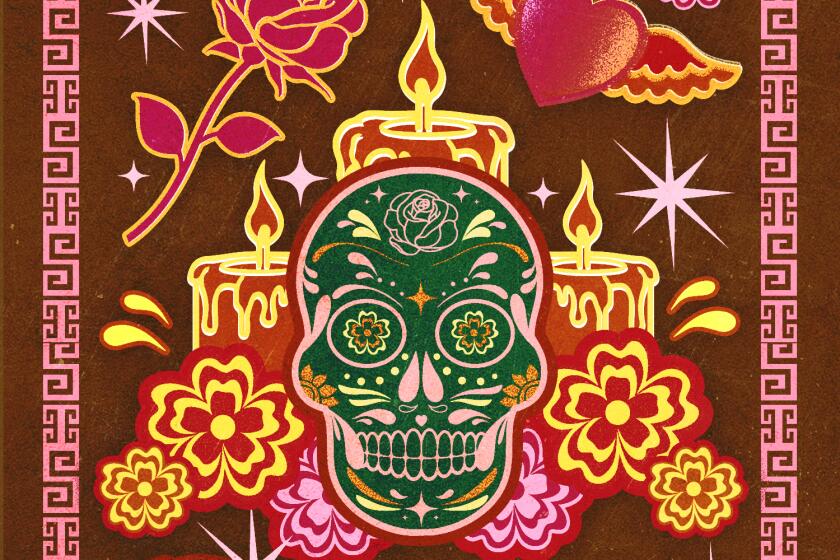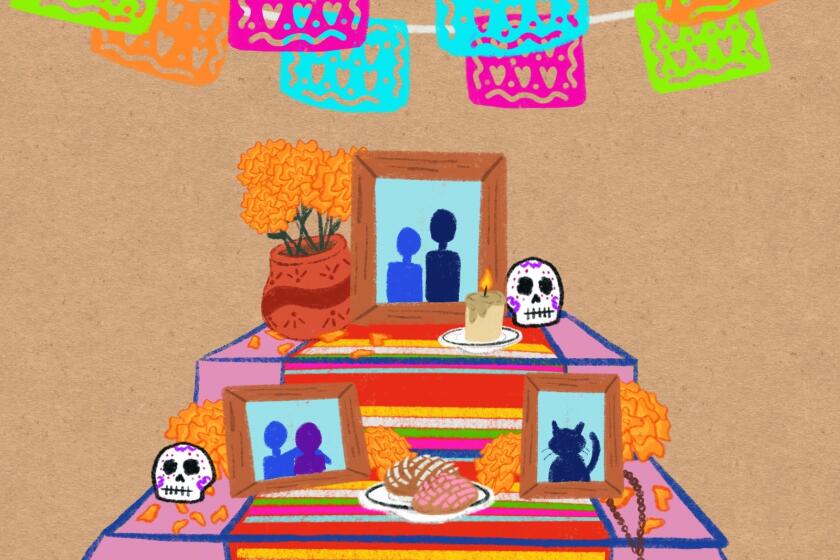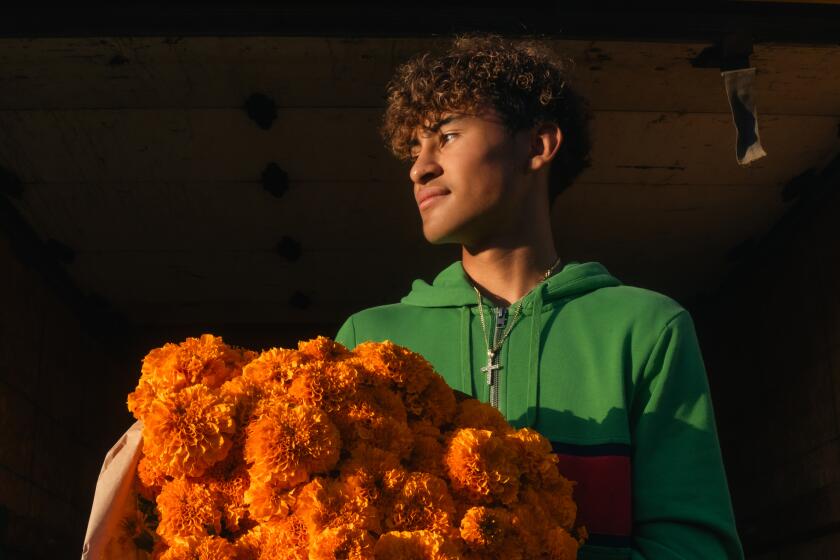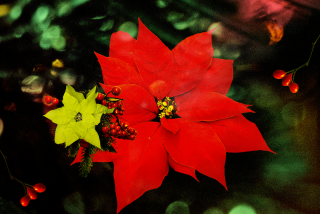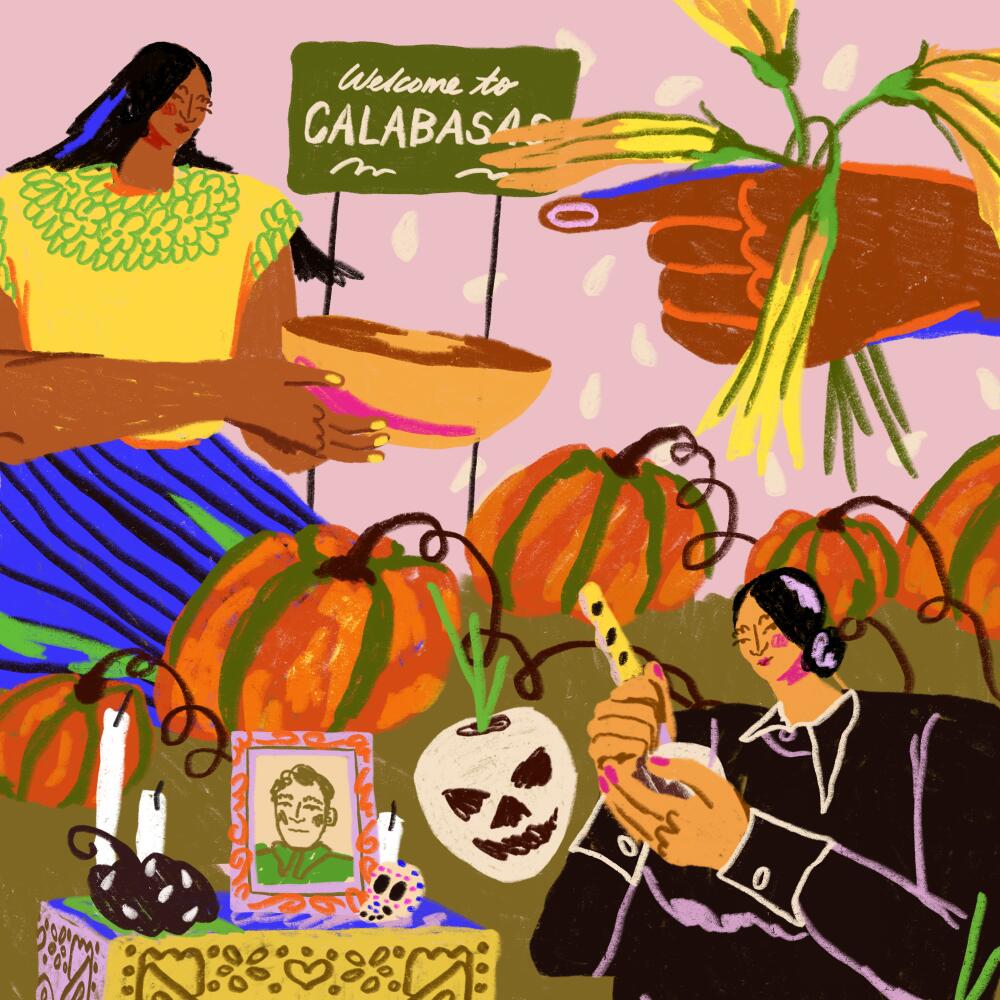
- Share via
Cut, gutted and carved with a grin — there’s no symbol that screams Halloween more than the warm glow of an orange pumpkin. They’re the mark of the fall season. Images of people visiting pumpkin patches, ordering pumpkin spice lattes, sipping crisp pumpkin ales and baking pumpkin pies color autumn days and cottage-core social media posts.
But as big a part of the autumnal U.S. culture as they’ve become, their origins point a bit more south to Mexico.
The oldest signs of the domesticated pumpkin point to Cucurbita pepo, according to Arqueología Mexicana.
Here’s your guide for events in L.A. and O.C. counties that are bringing the community together to celebrate Día de Muertos.
Cucurbita pepo is one of the most used pumpkins, from acorn to zucchini. Seeds have been found dating back to 2000 BC in the Romero cave in Tamaulipas . But the oldest record remains in the Guilá Naquitz cave in Oaxaca, where evidence of orange field pumpkins has been found and dated back to 8000 BC — more than 10,000 years ago.
Not only is the pumpkin an ancient fruit known to exist for millenniums but it’s also thought to be the first to be cultivated.
Wild squashes prospered in the Americas before the arrival of humans. They grew near floodplains and were consumed by mammalian herbivores. Eventually, the presence of humans, who hunted the herbivores, threatened the existence of certain species of squash. Luckily, humans found the nutritional value in squash before they became extinct and were able to help it survive.
Most of us know what Día de Muertos is but are unfamiliar with the history behind the tradition that is now celebrated each year.
Mesoamericans began to cultivate pumpkins that were as small as tennis balls and bitter in flavor. They began consuming toasted squash seeds once they discovered their ability to keep for long periods of time and sustain energy from their high levels of protein. Since then, it’s become an integral staple to the Mesoamerican — and modern Mexican — diet, where all parts of the plant are used: the fruit, stems, flowers and seeds.
Indigenous cuisine in pre-Hispanic and modern eras used pumpkin leaves, considered quelites (young, tender herbs), in soups and stews, along with the flesh, stems and flowers. Maya dishes that use pumpkin abound.
Pipián, a type of mole, is made using toasted pumpkin seeds. K’ol de iguana is a thick stew that uses pumpkin seed with pumpkin flesh that is boiled and then fried with onion and tomato. X’ka’ita pumpkins are used in a stew called joroch de x’ka’ita.
Flower vendors in the Flower District of downtown L.A. prepare cempasúchils for ofrendas and Día de Los Muertos celebrations weeks in advance.
Beyond food preparation and classic dishes, which also include tamales and atoles, there was evidence that squash was also used to make containers, according to La Fundacion Tortilla. Dried out and shaped into bowls, squash was used in the Maya region as offerings to the gods for blessings over their harvest.
Today, Mexican cuisine carries the torch lighted by Mesoamerican culture, boasting pumpkin loudly in the cuisine, preserving Indigenous dishes and cultivating post-colonial ones. It’s made into creamy soups and turned into ice cream, pies and stews. Pumpkin seeds serve as appetizers and are used in mole. Its flowers are folded into tortillas with melting white cheese and tucked into tamales.
At Xokol, a restaurant in Guadalajara, pumpkin is served as a chile atole with seeds. At the Bolita Masa pop-up in the Bay Area, quesadillas are stuffed with squash blossoms, and a variation of vegan masa is made using kabocha.
Whether La Llorona is held up as a form of resistance against oppression, owning her power or reclaiming the monstrous bruja within, the narratives of the wailing woman have endured for centuries, reimagined into a radical icon.
In New York, the restaurant La Moradita serves chicken vegetable soup with thick chunks of squash. And in Los Angeles, Ditroit serves a ratatouille tamal, while Damian, another L.A. restaurant, uses squash and its blossoms for a summer tlayuda. Comal, an L.A. pop-up by chef Andy Zambrano, uses zucchini and blossoms to top a pizza in collaboration with Lucky Nick’s Pizza.
During Dia de Muertos festivities, pumpkins are used decoratively and set on altars along with candles, photos of dead relatives, cempasúchil flowers, candy skulls, the dead’s favorite foods and more. Calabaza en tacha, a dish that uses the pumpkin’s flesh and is cooked with a syrupy piloncillo for dessert, is also eaten around this time. The dish got its name from the type of pot used, a “tacho,” and, according to Culinaria Mexicana, originated in Puebla, Mexico.
The plump orange rounds that are carved for the spooky season are a Cucurbita pepo species known today as Connecticut Field pumpkins. In English, pumpkin has roots in the word pôhpukun, which means “grows forth round” in the Wôpanâak dialect of Massachusett. Colonial settlers later adapted the word to the English language and the fruit itself to their own diets.
The Día de Muertos parade is a sumptuous, extravagant delight. It might surprise some to hear that the parade stemmed from a single scene in a James Bond movie in 2015.
Carved pumpkins became an integral part of the fall equinox thanks to Irish immigrants. Inspired by a devilish cautionary tale, the Irish brought their tradition of carving turnip jack-o’-lanterns to America in the 19th and early 20th centuries. They eventually traded the turnips for pumpkins, which were easier to carve ghoulish faces into.
Beyond their devilish connotations, pumpkins also left their mark in the Southland, where Calabasas got its name as “a tribute to the pumpkin patches that reputedly dotted the area long ago,” according to the city’s Chamber of Commerce. The community’s last pumpkin patch was harvested in 1987, as reported by The Times.
And now this ancient bulbous fruit, universally synonymous with harvest and Halloween, lives on in legend and in the flesh, from beverage to dish to ornament, as connective tissue to the past and comfort into the future, that the pumpkins will once again bloat up from the ground and our traditions will endure.
Andrea Aliseda is a food and culture writer, vegan recipe developer and dog mom based in Brooklyn, NY, with published work in Harper’s Bazaar, Bon Appetit and Epicurious. She’s currently working on her debut plant-based Mexican cookbook, and you can find her on Instagram at @andrea__aliseda.
More to Read
The Latinx experience chronicled
Get the Latinx Files newsletter for stories that capture the multitudes within our communities.
You may occasionally receive promotional content from the Los Angeles Times.
